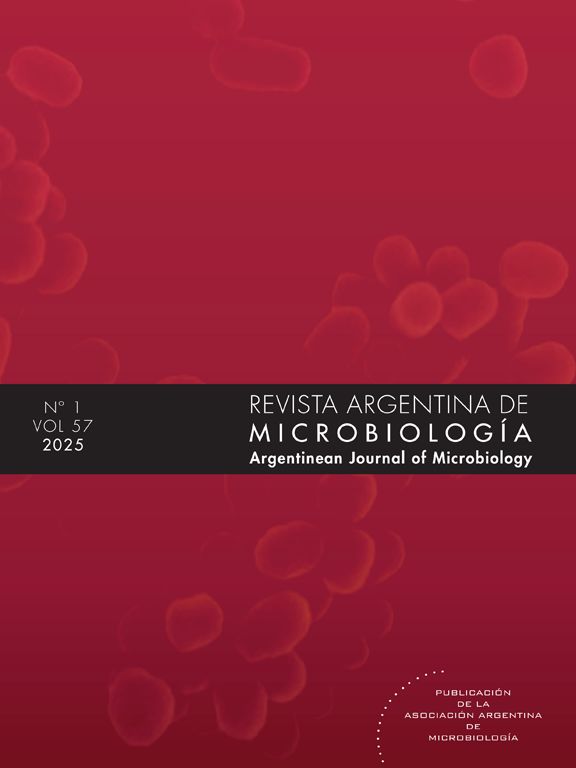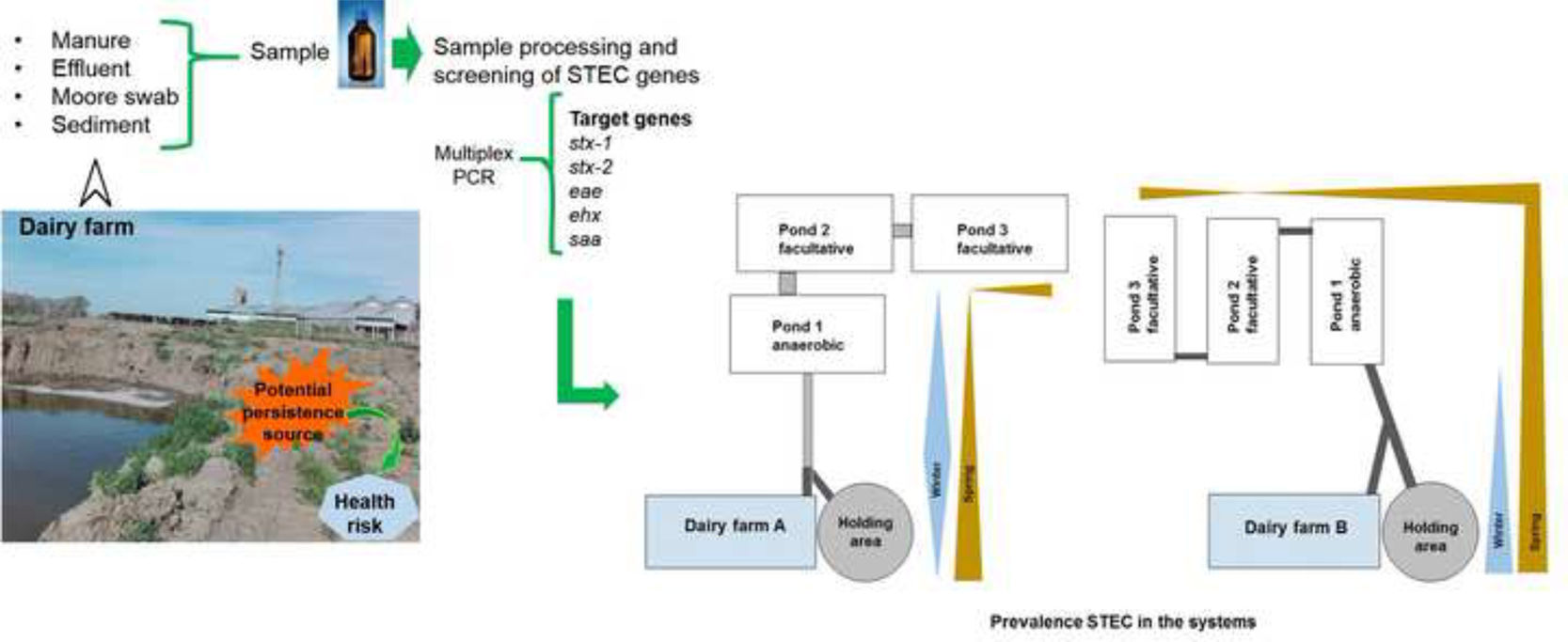2580
Intervención educativa como estrategia de prevención de parasitosis intestinales y valoración del estado enteroparasitológico en centros de desarrollo infantil de la ciudad de Santa Fe, ArgentinaCésar Ernesto Gutiérrez, María Agustina Jaras Horno, Carolina Aro, Andrea Florencia Gómez Colussi, María Belén Cheirano, Érica Soledad Rodríguez, María Verónica Vera Garate, Guillermo García Effron, Sergio Adrián Guerrero
Rev Argent Microbiol. 2025;57:8-13
2580
Highlights
- -
La intervención educativa fortaleció los conocimientos relacionados a las parasitosis
- -
Las actividades «lúdico-pedagógicas» son estrategias educativas apropiadas para la prevención
- -
50% de la población infantil analizada estaba parasitada
- -
Se evidenció predominio de protozoos en relación a helmintos (77,7% vs. 22,3%, respectivamente)
- -
Se detectó con mayor frecuencia Blastocystis sp., Giardia intestinalis y Ascaris lumbricoides
532
Update of diagnostic methods in tuberculosis (TB)Mario José Matteo, María Cecilia Latini, Davor Nicolás Martinovic, Marina Bottiglieri
Rev Argent Microbiol. 2025;57:49-53
532
Highlights
- •
The “End TB” strategy aims to reduce deaths and incidence from 2015 to 2035.
- •
Rapid diagnostic tests recommended by WHO are cost-effective.
- •
Traditional and new diagnostic techniques for TB were reviewed.
- •
Includes IGRA, smear, culture, molecular methods, and lipoarabinomannan antigen.
528
Bartolinitis por Neisseria meningitidis: caso clínicoElena Berardinelli, Marcela Sokol, Laura Dufranc, Vanina Diaz, Viviana Eiras, Ariel Gianecini, Patricia Galarza, Paula Gagetti, ... Adriana Efron
Rev Argent Microbiol. 2025;57:63-5
528
Highlights
- •
Neisseria meningitidis como agente etiológico de bartolinitis en mujer heterosexual.
- •
La cepa se identifica como Neisseria meningitidis B complejo clonal ST-35.
- •
La práctica de sexo orogenital podría constituir la vía de transmisión.
- •
Neisseria meningitidis como posible agente causal de infección de transmisión sexual.
445
Detection of EPEC and STEC strains isolated from children with diarrhea in ArgentinaDaniel Fernández Fellenz, Julia M. Ruiz, Analía I. Etcheverría, Rocio Colello, María V. Velez, Marcelo E. Sanz, Mónica D. Sparo, Sabina Lissarrague, ... Nora L. Padola
Rev Argent Microbiol. 2025;57:59-62
445
Highlights
- •
Stool samples from 122 children diagnosed with acute diarrhea were recollected for detection of STEC and EPEC pathotypes.
- •
E. coli were detected in 68% of the stool samples, of which 18.8% were STEC or EPEC.
- •
STEC O145 and EPEC O130, O113 and O157 were the serotypes detected.
- •
DEC are not routinely tested in clinical laboratories and proper surveillance is necessary.
410
Impact of gestational diabetes mellitus in gut and human breast milk microbiome in Colombian women and their infantsSandra Y. Valencia-Castillo, Mayte J. Hernández-Beza, Irisbeth Powell-Cerda, Erika Acosta-Cruz, Guadalupe C. Rodríguez-Castillejos, Fernando Siller-López, Humberto Martínez-Montoya
Rev Argent Microbiol. 2025;57:14-23
410
Highlights
- •
Our study revealed noticeable differences in the gut microbiome of women with GDM.
- •
In GDM women's gut, Bifidobacterium, Serratia, and Sutterella were in low abundance.
- •
The diversity and abundance of gut bacteria in GDM infants are similar to that of their mothers.
- •
The analysis of GDM HBM showed Sutterella, Serratia, and Lactococcus in low abundance.
- •
Our results suggest that GDM women could lead to dysbiosis in breast-fed infants.
361
Identification of Salmonella Enteritidis, Salmonella Typhimurium, Bacillus cereus, Bacillus subtilis, and Clostridium perfringens in hospital foodMohammad Hashemi, Arefeh Erfani, Fateme Asadi Touranlou, Maliheh Doustinouri, Afsaneh Shahraki, Asma Afshari
Rev Argent Microbiol. 2025;57:78-85
361
Highlights
- •
Bacillus cereus and Clostridium perfringens were detected in 4 out of 360 food samples.
- •
Bacillus subtilis was not detected in any of the food samples.
- •
The most contaminated food samples were salad, kebab, and rice.
- •
Salmonella typhi and Salmonella enteritidis, caused the most food contaminations among the investigated pathogens.
334
Rapid discrimination of Salmonella Enteritidis from other serovars with MALDI-TOF MS in ArgentinaAgustina Costa, Florencia Catalano, Andrea Alcain, Marcela Panagopulo, Jesús Emmanuel Riquel Moyelak, Silvina Brengi, Mirian Moroni, María Rosa Viñas
Rev Argent Microbiol. 2025;57:24-32
334
Highlights
- •
Salmonella is an important zoonotic pathogen causing foodborne diseases.
- •
Traditional Salmonella typification assays have a turn-around-time of 3–7 days.
- •
S. Enteritidis specific biomarkers detection with MALDI-TOF MS was achieved.
- •
This protocol could be used in clinical laboratories for S. Enteritidis detection.
314
Staphylococcus aureus resistentes a meticilina aislados de teléfonos móviles de estudiantes de Enfermería en Cuenca, EcuadorNube María Tenezaca Lliguin, Paola Patricia Orellana Bravo, Carlos Fernando Andrade Tacuri, Jonnathan Gerardo Ortiz Tejedor
Rev Argent Microbiol. 2025;57:54-8
314
Highlights
- •
Este informe reveló datos sobre la colonización de S. aureus en teléfonos móviles:
- •
Muestra: 76 teléfonos móviles de estudiantes de Enfermería de último año.
- •
Frecuencia de S. aureus: 11,84%.
- •
SARM: 44%.
- •
Los aislamientos de S. aureus portaron genes de virulencia: hla, hlb. sec, sea y tst
- •
Los teléfonos móviles actúan como reservorios de S. aureus en la asistencia sanitaria.
263
Dairy effluent management systems as a potential persistence source of Shiga toxin-producing Escherichia coli (STEC) strainsJessica Basualdo, Gastón A. Iocoli, Marisa A. Gómez, María Celina Zabaloy
Rev Argent Microbiol. 2025;57:70-7
263
Highlights
- •
The presence of STEC has been confirmed in various types of samples and points in the system.
- •
Management practices influence the prevalence of STEC strains in dairy farms.
- •
Positive STEC samples increase during spring.
- •
Genetic profiles associated with HUS were detected in samples.
- •
The high persistence of STEC in sediments is associated with the potential to form biofilm.
250
Potential use of Apis mellifera L. honey in the management of the cucurbit powdery mildew caused by Podosphaera xanthii (Castagne) under greenhouse conditionsJuan Antonio Castro-Diego, Carlos Alfonso López-Orona, Verónica Delgado-Pacheco, Miguel Armando López-Beltrán, Nancy Ley-López, Walter Arturo Rubio-Aragón, Jorge Alberto Edeza-Urías
Rev Argent Microbiol. 2025;57:66-9
250
Highlights
- •
Honey is a natural antimicrobial for plant pathogens including fungus.
- •
Few reports about the use of honey in the agriculture have been reported.
- •
This is the first in vivo study with the aim of evaluating honey as fungicide under greenhouse conditions.
- •
Honey at 3.0 and 3.5% have a similar statistical control to Podosphaera xanthii as the chemical fungicide Azoxystrobin 2g/l.
- •
Results provide preliminary data of honey as control strategy to Podosphaera xanthii.







